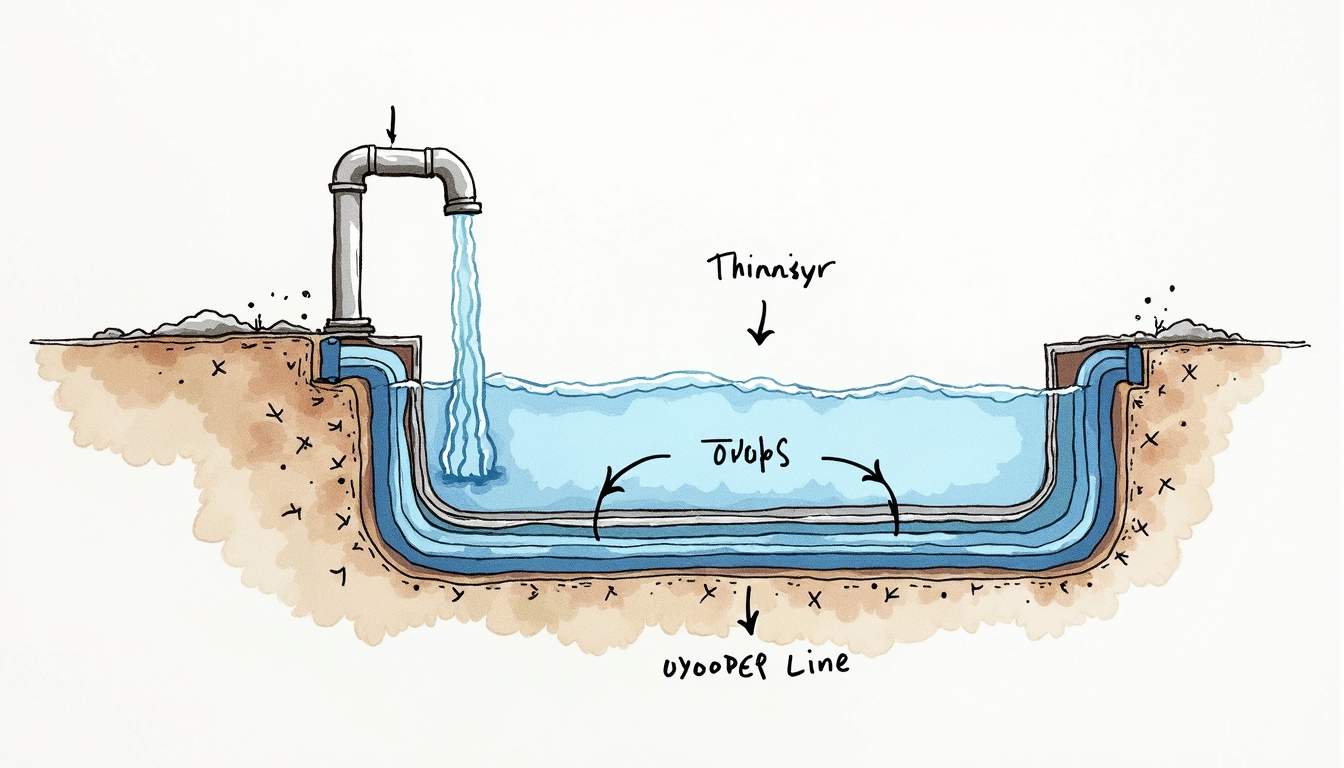
Where Does Shower Water Go: Understanding Your Home's Drainage System
Every time a shower is taken, a significant amount of water flows down the drain, but have you ever wondered where that water goes? Understanding your home's drainage system is crucial not only for maintaining your plumbing but also for ensuring the overall health of your home. This article delves into the journey of shower water, exploring how it travels through your drainage system and the importance of proper maintenance.
The Basics of Home Drainage Systems
At its core, a home's drainage system is designed to transport wastewater away from the house. This system is comprised of various components, each playing a vital role in ensuring that water is effectively removed from the premises. A well-functioning drainage system is essential not only for hygiene but also for the structural integrity of the home, as stagnant water can lead to mold growth and foundation issues.
Components of the Drainage System
The drainage system includes pipes, fixtures, and vents. The pipes are usually made of PVC or cast iron and are responsible for carrying wastewater away from sinks, showers, and toilets. Fixtures, such as drains and traps, help to prevent clogs and ensure that odors do not escape into the living space. Vents allow air to enter the system, which helps maintain proper pressure and flow. Additionally, cleanouts are strategically placed access points in the drainage system that allow for easy maintenance and inspection, ensuring that blockages can be quickly addressed before they escalate into more significant problems.
How Water Travels Through the System
When you take a shower, the water flows down the drain and into the home's plumbing system. From there, it travels through a series of pipes that lead to the main sewer line or a septic system. Gravity plays a significant role in this process, as the water moves downward through the pipes. In some cases, pumps may be used to assist in moving water, especially in homes with basements. It's also important to note that the slope of the pipes, known as the drainage grade, must be carefully calculated; too steep a slope can cause water to flow too quickly, while too shallow a slope can lead to stagnation and clogs.
The Role of Gravity and Pressure
Gravity is the primary force that facilitates the movement of wastewater through the drainage system. However, pressure also plays a crucial role. Proper venting ensures that air can flow freely through the pipes, preventing vacuum conditions that could hinder drainage. Understanding these forces can help homeowners appreciate the complexity of their drainage systems. Moreover, the integration of modern technology, such as smart sensors that monitor water flow and detect leaks, is becoming increasingly common. These advancements not only enhance efficiency but also provide peace of mind, allowing homeowners to address potential issues before they develop into costly repairs.
The Journey of Shower Water
Once the water drains from the shower, it embarks on a journey through the plumbing system. This journey is essential for understanding how wastewater is handled and what happens to it after it leaves your home.
From the Shower to the Main Drain
After water leaves the shower, it enters the drain, which is typically equipped with a trap. The trap serves two purposes: it prevents sewer gases from entering the home and it captures debris that could cause clogs. The water then flows into larger pipes that lead to the main drain, which is the central hub for all wastewater in the home. This main drain is often a crucial part of a home's plumbing infrastructure, designed to handle not just shower water but also wastewater from sinks, toilets, and appliances. As the water travels through these pipes, it can pick up various substances, from soap residues to hair, which can accumulate over time and necessitate regular maintenance to prevent blockages.
Connection to the Sewer System
The main drain is connected to either a municipal sewer system or a private septic system. In urban areas, the wastewater is directed to a sewer line managed by the local government. This line carries the water to a wastewater treatment facility, where it undergoes purification processes before being released back into the environment. At the treatment facility, the water is subjected to several stages of filtration and biological treatment, where microorganisms break down harmful substances. This process not only cleans the water but also helps in recovering valuable resources, such as biogas, which can be used to generate energy, showcasing an innovative approach to waste management.
Septic Systems: An Alternative Approach
In rural areas, homes may rely on septic systems. These systems consist of a septic tank and a drain field. Wastewater flows into the septic tank, where solids settle at the bottom and liquids flow out into the drain field. Here, the water is naturally filtered through soil, allowing it to safely re-enter the groundwater supply. The effectiveness of a septic system heavily relies on proper maintenance, including regular pumping of the tank to remove accumulated solids. Additionally, the design of the drain field is critical; it must be situated in an area with adequate soil drainage and away from water sources to prevent contamination. Understanding the intricacies of septic systems can help homeowners make informed decisions about their wastewater management and ensure a sustainable approach to their environmental footprint.
Importance of Maintenance
Understanding where shower water goes is only part of the equation; maintaining the drainage system is equally important. Regular maintenance can prevent clogs, backups, and costly repairs down the line. A well-functioning drainage system not only enhances the efficiency of your plumbing but also contributes to the overall hygiene and comfort of your home. Neglecting maintenance can lead to more serious issues, such as water damage or mold growth, which can pose health risks and require extensive repairs.
Common Issues and Solutions
Clogs are one of the most common issues homeowners face with their drainage systems. Hair, soap scum, and other debris can accumulate in the pipes, leading to slow drainage or complete blockages. Regularly cleaning the drain and using a hair catcher can help mitigate this problem. Additionally, employing natural solutions like baking soda and vinegar can effectively break down minor clogs without the need for harsh chemicals. For persistent issues, consider using a plumbing snake to remove deeper blockages that may not be reachable through standard cleaning methods.
Signs of Drainage Problems
Homeowners should be vigilant for signs of drainage issues, such as slow-draining sinks or showers, unpleasant odors, or gurgling sounds from the pipes. These symptoms can indicate a blockage or other problems within the system that require attention. It's also wise to keep an eye out for water pooling around the base of fixtures or damp spots on walls, which can signal leaks or more serious drainage issues. Early detection of these signs can save homeowners from facing more significant damage and repair costs in the future.
Professional Inspections
While some maintenance tasks can be performed by homeowners, professional inspections are recommended at least once a year. A plumber can assess the system for potential issues and provide necessary repairs or recommendations to keep everything running smoothly. During these inspections, professionals can also check for tree root intrusions, which can cause significant damage to underground pipes, and evaluate the overall condition of the plumbing system. Investing in a professional inspection can provide peace of mind and ensure that your drainage system remains in optimal condition, ultimately prolonging its lifespan and functionality.
Environmental Considerations
The journey of shower water also raises important environmental considerations. How wastewater is treated and disposed of can have significant implications for local ecosystems. With increasing urbanization and population density, the strain on wastewater management systems has become more pronounced, making it crucial to address these issues to protect our natural resources.
Wastewater Treatment Processes
Municipal wastewater treatment facilities employ various processes to clean sewage before releasing it into rivers or oceans. These processes typically include physical, biological, and chemical treatments to remove contaminants and ensure that the water is safe for the environment. Physical treatments often involve screening and sedimentation to remove larger solids, while biological treatments utilize microorganisms to break down organic matter. Chemical treatments may involve the addition of chlorine or other agents to eliminate pathogens, ensuring that the treated water meets safety standards before being discharged.
Impact of Septic Systems on the Environment
Septic systems, while effective for individual homes, can pose environmental risks if not properly maintained. If a septic tank overflows or leaks, it can contaminate groundwater and local water sources. Regular pumping and inspections are essential to prevent such issues. Moreover, the improper installation of septic systems can lead to inadequate drainage and increased nutrient runoff, which can contribute to harmful algal blooms in nearby lakes and rivers. Homeowners must be educated about the signs of septic system failure, such as foul odors or slow drainage, to mitigate these risks effectively.
Water Conservation Practices
In addition to understanding the drainage system, homeowners can adopt water conservation practices to reduce the amount of wastewater generated. Simple changes, such as installing low-flow showerheads and fixing leaks, can significantly decrease water usage and lessen the burden on the drainage system. Furthermore, utilizing rain barrels to collect runoff from roofs can provide an alternative water source for gardening and landscaping, reducing reliance on treated municipal water. By incorporating drought-resistant plants into their gardens, homeowners can also minimize water consumption while promoting biodiversity and creating habitats for local wildlife.
Innovations in Drainage Systems
As technology advances, so too do the methods used in home drainage systems. Innovations are emerging that can enhance efficiency and reduce environmental impact. These advancements not only improve functionality but also contribute to sustainable living practices, aligning with the growing emphasis on environmental responsibility in home construction and renovation.
Smart Drainage Solutions
Smart technology is making its way into home plumbing systems. Smart sensors can detect leaks and monitor water usage, alerting homeowners to potential issues before they escalate. These systems can help save water and reduce repair costs. Furthermore, some smart drainage solutions can integrate with home automation systems, allowing homeowners to control and monitor their drainage systems remotely via mobile apps. This level of control not only provides convenience but also empowers homeowners to make informed decisions about their water usage and maintenance schedules.
Eco-Friendly Materials
Many manufacturers are now producing eco-friendly plumbing materials designed to minimize environmental impact. These materials are often more durable and can withstand the test of time, reducing the need for frequent replacements. Additionally, some eco-friendly options are made from recycled materials, further promoting sustainability. For instance, pipes made from recycled plastics or composite materials not only reduce waste but also offer improved insulation properties, which can help in maintaining optimal temperatures and reducing energy costs associated with heating or cooling systems.
Advanced Treatment Options
New wastewater treatment technologies are being developed to improve the efficiency of treatment processes. Innovations such as membrane bioreactors and advanced oxidation processes can enhance the quality of treated water, making it safer for discharge into the environment. These advanced treatment options not only focus on removing contaminants but also aim to recover valuable resources, such as nutrients and energy, from wastewater. This resource recovery approach is gaining traction as it aligns with the principles of circular economy, where waste is minimized, and materials are reused, ultimately contributing to a more sustainable future.
Conclusion
Understanding where shower water goes is essential for every homeowner. By gaining insight into the drainage system, its components, and the journey of wastewater, individuals can make informed decisions about maintenance and environmental responsibility. Regular upkeep and awareness of potential issues can lead to a healthier home and a more sustainable future.
As technology continues to evolve, the drainage systems of the future will likely become even more efficient and eco-friendly. By staying informed and proactive, homeowners can ensure that their plumbing systems serve them well for years to come.
